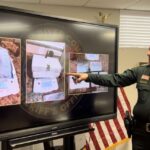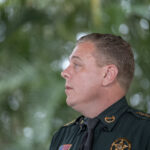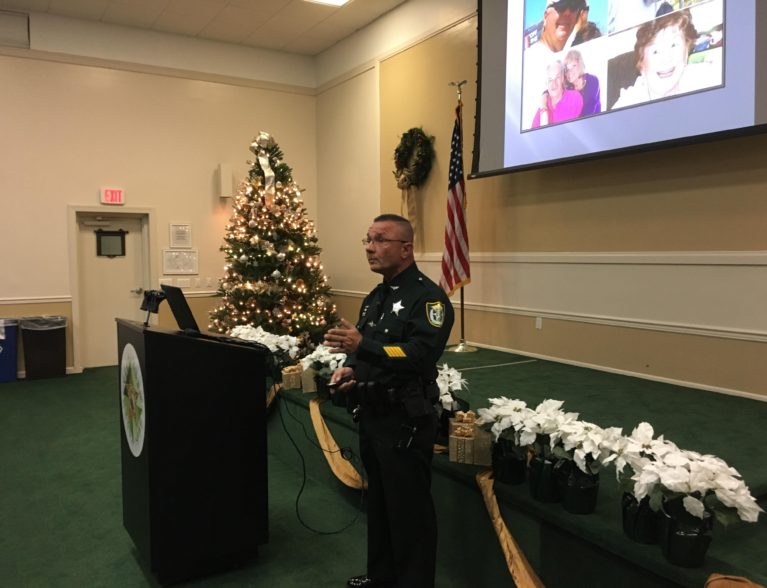
INDIAN RIVER COUNTY — Sheriff’s deputy Clifford Labbe recalled shattered windows, shell casings on the ground and bullet holes riddled through tiles in the walls and front doors as he responded to the Sandy Hook Elementary School shooting six years ago.
Labbe said he worked as one of the commanding officers at the scene, which took several weeks to process. Labbe was working as a trooper with Connecticut State Police at the time before coming to the Indian River County Sheriff’s Office in 2015.
“It’s something I’ll never forget,” Labbe said of the Sandy Hook incident, considered one of the deadliest school shootings in U.S. history.
It took less than five minutes for lone gunman Adam Lanza to fire 156 rounds from a semi-automatic rifle and two handguns on Dec. 14, 2012. The 20-year-old fatally shot 20 first grade students and six adult staff members at the Newtown school, before shooting and killing himself, Labbe said.
Labbe, now 54 and an Indian River County sheriff’s school resource officer, wants residents to have a plan and take action in case they find themselves in an active shooter scenario. His three main points – run, hide and fight.
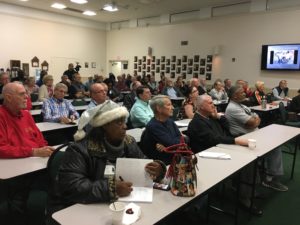
The crowd listens to sheriff’s deputy Clifford Labbe Jr. Monday Dec. 10, 2018, during a presentation at the sheriff’s office on how to respond to active shootings. PHOTO BY NICK SAMUEL
“The first 30 seconds of an attack and the action you take can make the difference in your survival,” Labbe told the Indian River County Pastor’s Association late Monday during an active shooter presentation at the sheriffs office auditorium. “Do something to save your life.”
Anytime, Anyplace
Labbe noted that most active shootings are over by the time police arrive.
He said they can happen at anytime and anyplace. Florida has seen dozens of lives lost in recent years because of such shootings, including the 2016 Pulse night club massacre that left 49 dead and the more recent Marjory Stoneman Douglas High School shooting that killed 17.
Labbe said the shooters have no method for who they choose to shoot and kill. Other weapons can also be used in critical incidents to harm others, such as a driver using a vehicle to plow through a crowd of people.
Situational Awareness
Authorities said people should call police if they see anything suspicious.
Lanza’s mother, who Lanza fatally shot at their home before going to Sandy Hook, should have spotted several red flags with her son prior to the school shooting, Labbe said. For example, Lanza spent most of his time downstairs playing online games.
He taped plastic bags over the windows to his room and even researched mass shootings dating back to the 1800s, Labbe said.
“See something, say something,” Labbe said, pointing out that spotting the warning signs could potentially save lives.
In Indian River County, residents have put this motto to use by calling the sheriff’s office school tip hotline. The hotline was created following the Feb. 2018 mass shooting at Marjory Stoneman Douglas High School in Parkland.
Local law enforcement increased their presence at all public and charter schools earlier this year. Increased security has led to six arrests involving guns on school campuses within the county this year.
People should always have a plan if an emergency arises.
One example could be for employees to create a code word or have an alarm buzzer at their workplaces if they encounter an angry or threatening customer, Labbe said. People should be aware of all the exits in their building.
Have a Plan
Those trapped in a critical incident may find themselves confused, panicked and even too scared to move. Too offset this, Labbe said, have a plan.
“What would I do if something were to happen?” he added.
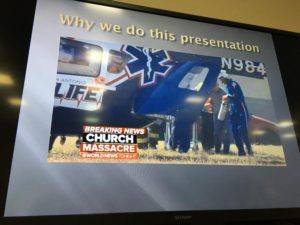
Attendees watched a slide show at the sheriff’s office on how to respond to active shooter scenarios.
PHOTO BY NICK SAMUEL
First, victims should run away if they are able. Once victims are in a safe area far away, they should warn others and then call 911.
Labbe said this advice may not work in all situations.
For example, in a hospital where there are bedridden patients, victims might not be able to leave so quickly. Doctors or caretakers would have to make the difficult choice of running to save their own lives, or staying to make sure the patients are safe, Labbe said.
If people can not leave a building, they should find a room and lock the doors. People should then push furniture up against the door, turn off the lights and their cell phones, Labbe said.
Victims who are barricaded should not open the door for anyone. Law enforcement will find a way to get to the victims, Labbe said.
Lastly, the victims should attack the shooter, but only as a last resort. Victims should arm themselves with anything that could be used as a weapon and beat the suspect.
Some possible weapons that can be used include fire extinguishers, knives, scissors, chairs and books. Victims who attack the shooter should aim for the eyes, nose and neck, Labbe said.
“Strike anything above the neck. If they cannot see, they cannot fight,” Labbe said. “Never hesitate. Once you start, don’t stop.”
Good guys with guns
A recent shooting during a Thanksgiving event at an Alabama mall that wounded two people gained national attention after a responding officer shot and killed the wrong person. The officer shot 21-year-old Emantic Bradford Jr. instead of the shooter.
Police in Hoover, Alabama, initially said Bradford was the shooter, but later changed their story, saying he likely did not fire any rounds. Bradford, who had a weapon on him at the time, had a license to carry a concealed hand gun, a family attorney told media.
In Monday night’s presentation at the local sheriffs’ office, more than half of the 52 attendees raised their hands when asked if they carry concealed weapons. Some voiced concern about what they should do in an active shooter situation.
Labbe replied, “You have a right to use deadly force to protect yourself, only if your life is in danger.”
Citizens should not pursue the shooter, Labbe said. Residents should put their guns down and their hands up to let others know they are not the shooter.
Florida law and policies can prohibit residents from carrying concealed weapons at places such as police stations, schools, prisons, courthouses and other public facilities.
Community Response
Parishioners from several churches said the tips on how to respond in active shooter situations was more than helpful.
Mike Kicfer, who attends First United Methodist Church in Vero Beach, said he is on the safety team at the congregation. Kicfer said the team focuses on monitoring the outside of the church as a precaution.
Angela Cletzer, a member at First Baptist Church of Wabasso, said she attended the presentation because she was concerned about the older population at her church. Cletzer, 57, of Sebastian, said some might not be able to run if a shooting occurred.
More Training Available
Labbe’s training session is just one of many offered in the county.
The sheriff’s office has held active shooter training presentations at least once a month at various locations for the past year, sheriff’s spokesman Maj. Eric Flowers said. The sheriff’s office conducts the presentations upon request, with some held for certain groups.
Vero and Sebastian police departments also hold the training, according to the agency spokespersons. The Fellsmere Police Department and Indian River Shores Public Safety Department do not conduct the presentations, according to the agency spokespersons.
Those who want further details on the response training can contact Labbe at 772-539-1367 or clabbe@ircsheriff.org.
Residents can also contact Flowers at 772-473-8181 or eflowers@ircsheriff.org.
“Don’t just survive, win,” Labbe said.




